Common: dwarf Schefflera, dwarf umbrella tree, Hawaiian umbrella tree
The Schefflera arboricola is native to Taiwan and the pacific islands and gained popularity as bonsai material among Japanese migrants to the Hawaiian Islands. It has a storied history in Hawaii and has become extremely popular as indoor bonsai across the world:
- It's a fast-growing plant and takes on an aged look after just a few years
- It does well in the temperature range of human homes, though it does prefer higher humidity
- Since they are popular houseplants, they are widely available
- They respond well to pruning and wiring
- They grow aerial roots in humid environments
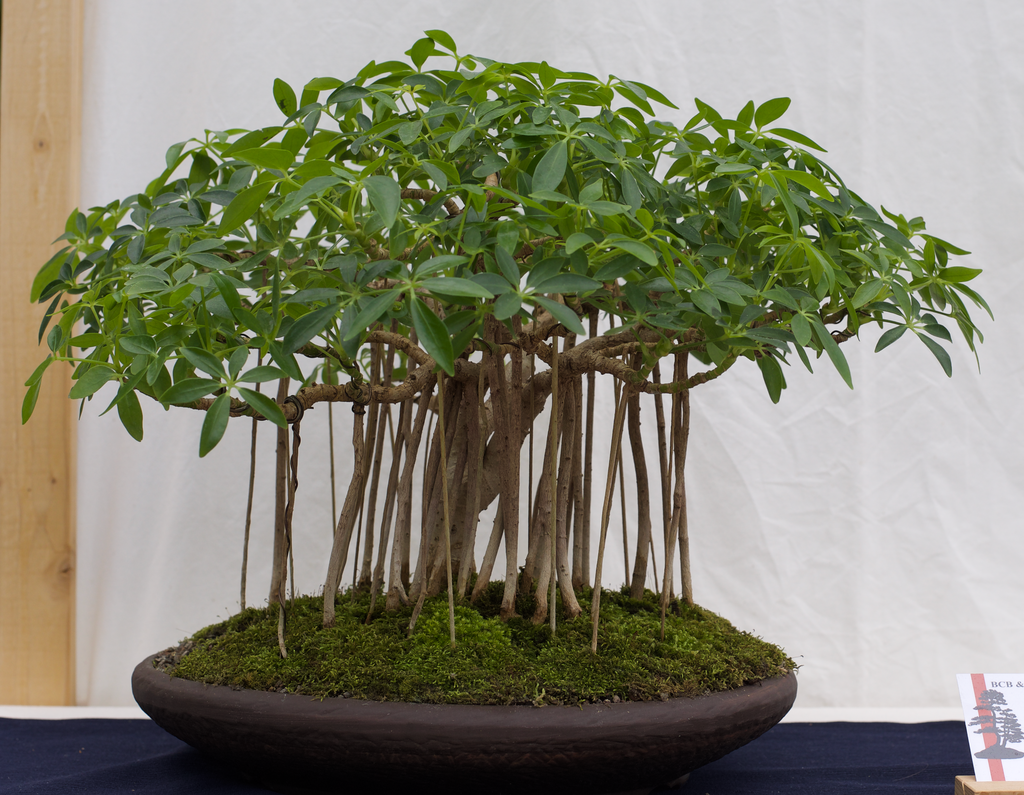
With so much going for it, it's no wonder the dwarf Schefflera has produced some of the most spectacular bonsai specimens. It will continue to be a popular species because it is robust enough for beginners, versatile enough for experts, and widely available. The Schefflera arboricola has become known by various names, including dwarf Schefflera, dwarf umbrella tree, and Hawaiian umbrella tree.
Schefflera Arboricola as a Tree
It is unclear exactly where the dwarf Schefflera originated or even if it is a valid species of Schefflera. Still, most sources claim it originated somewhere in the tropics between Taiwan and northern Australia. No matter where it is from, it has proven to be a very adaptable tree that has become naturalized across the region and is so robust that it is considered invasive in some tropical and subtropical areas.
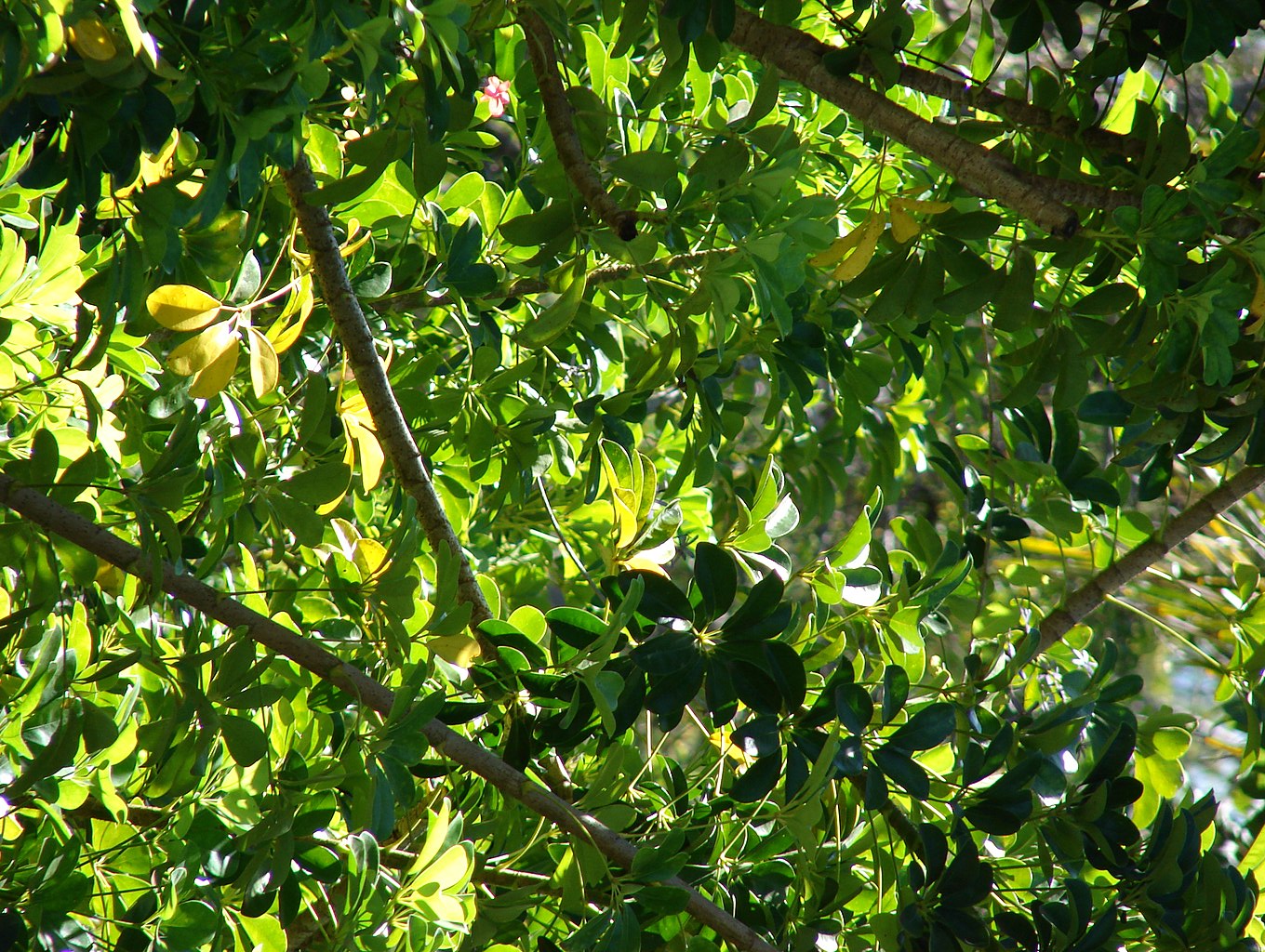
In the wild, the dwarf umbrella tree can grow up to 9m (~30ft) tall and tends to spread in patches. They can live as freestanding trees, but they often live as epiphytes by attaching themselves to other trees. Schefflera arboricola trees can grow abundant aerial roots, which help them find moisture and nutrients while growing on different trees.
In the fall, they produce flowers and then orange/yellow fruits that are popular food stock for some animals but inedible to humans. It does particularly well in tropical monsoon climates, with hot and humid periods followed by long periods of soaking rain. Soils in the mountain forests where it thrives are often poor, with nutrients quickly absorbed or washed away.
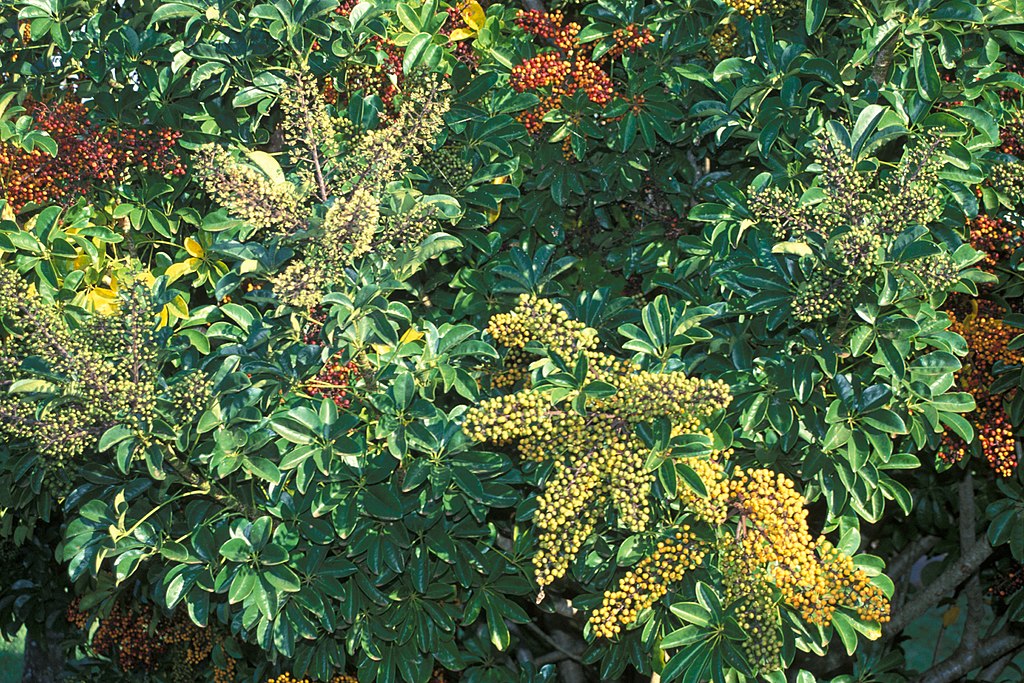
Lighting
As a natural epiphyte, Schefflera arboricola has adapted to growing in the dark shadows under the dense rainforest canopies. You often see them thriving in the meager office lighting or the darker corners of homes. The ability to survive in low light has been one factor that has made them popular as house plants.
Surviving and growing in low light doesn't mean they don't benefit from increased light. The truth is dwarf Schefflera love sunlight and does their best growing in sunny locations. You can supplement with artificial grow lights if needed. During warm months or in tropical areas, your bonsai would benefit from outside time. To prevent leaf burn, start by placing it in the shade and then gradually moving it into sunnier locations over a week or so.
Temperature and Humidity
Schefflera arboricola trees are tropical and cannot tolerate frost or temperatures near freezing. They can survive more extreme conditions, but as a general rule, keep them above 50F (10C) and below 85F (29.5C) to avoid damage.
Tropical trees can actively grow year-round, but giving them a dormancy period is best. To induce dormancy, move them into a cooler area, between 55F (12.7C) and 60F(15.5C) for 6 to 8 weeks in the wintertime. This cool-down time will allow your bonsai to recharge and get ready for strong growth in the spring.
Dwarf Schefflera trees love higher humidity; 60%-70% relative humidity is perfect, just like native jungle environments. While a human home typically stays in the correct temperature ranges, they are often far drier than the tree would prefer at 30-50% relative humidity. You can raise the humidity by misting the plants daily or using a humidity tray. Keeping the humidity high is essential if you want to grow aerial roots.
Soil
In nature, dwarf Schefflera bonsai do well in inferior soils and, as epiphytes, can survive without any actual soil. Due to rapid decomposition and nutrient erosion from high levels of rainfall, soil in their natural environment contains very little organic matter. Commercial bonsai mixes work great since they often have no organic matter.
You can easily mix soil yourself from commonly found parts. The critical aspects of the soil are that it is loose, not compacted so the roots can breathe and that it freely drains water because water-logged soil will result in root rot. These trees do well in soil with ample volcanic materials like pumice, lava rock, vermiculite, and perlite because these inorganic materials are lightweight, free-draining, and provide excellent aeration.
Schefflera arboricola bonsais, especially young ones in training and pre-bonsai states, also benefit from organic matter mixed in the soil. We recommend a mix of 60% inorganic material (pumice, lava, vermiculite, sand, etc.) and 40% organic materials (pine/fir bark, coco coir, peat moss, composted forest products, etc.).
Dwarf Schefflera bonsais prefer an almost neutral soil pH, between 6 and 7. You can add peat moss or pine bark to lower the pH (more acidic), and lime will raise the pH (more alkaline). Be careful when adjusting pH and test your soil since you can easily create an environment too caustic or acidic for the plant to survive.
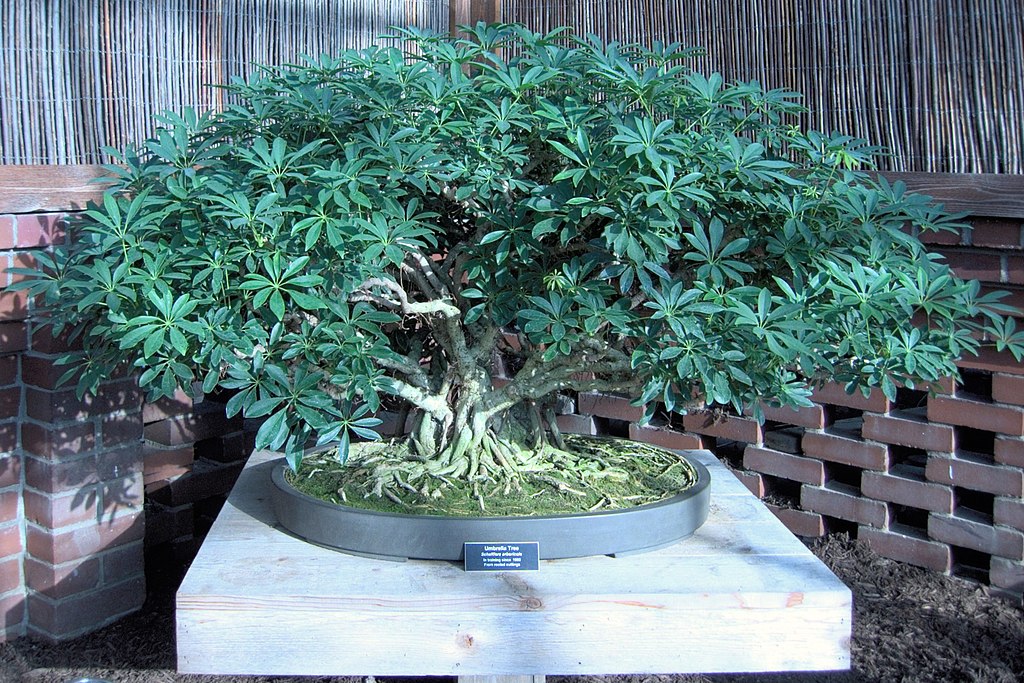
Water
Follow the same rule of thumb for dwarf Schefflera bonsai as with most varieties of bonsai: let the soil almost dry out between waterings but do not let it completely dry out. In the summertime, this likely means watering every day, depending on the size of the container. In cooler weather and while in dormancy, watering will be less frequent.
Make sure to water thoroughly each time until about 10% of the water runs from the bottom of the pot. Doing this will help ensure that all of the soil gets wet so the roots will expand to the entire potting area, and the runoff will help remove excess salts left by chemical fertilizers.
Fertilizer
Schefflera arboricola thrives in tropical monsoon climates, with hot and humid periods followed by long periods of soaking rain. Soils in mountain forests are often poor because organic matter decomposes rapidly, and nutrients are quickly absorbed or washed away. Like most epiphytes, the dwarf umbrella tree efficiently optimizes available nutrients and can still grow in nutrient-poor environments.
Just like with light, though, the dwarf Schefflera does even better with ample access to nutrients. Use a balanced, water-soluble fertilizer once per week during the peak growing season and once per month during the cooler seasons. Follow the manufacturer's instructions; overfertilizing can lead to burnt leaf tips, and under fertilizing can lead to sluggish growth, either will eventually kill your bonsai.
Repotting
Dwarf Schefflera trees are relatively strong root growers and will quickly fill up a pot. It is good to check your pot at least once a year and repot if they are rootbound and roots have displaced most of the soil. These trees handle root pruning very well, so you can replant them in the same pot for several seasons.
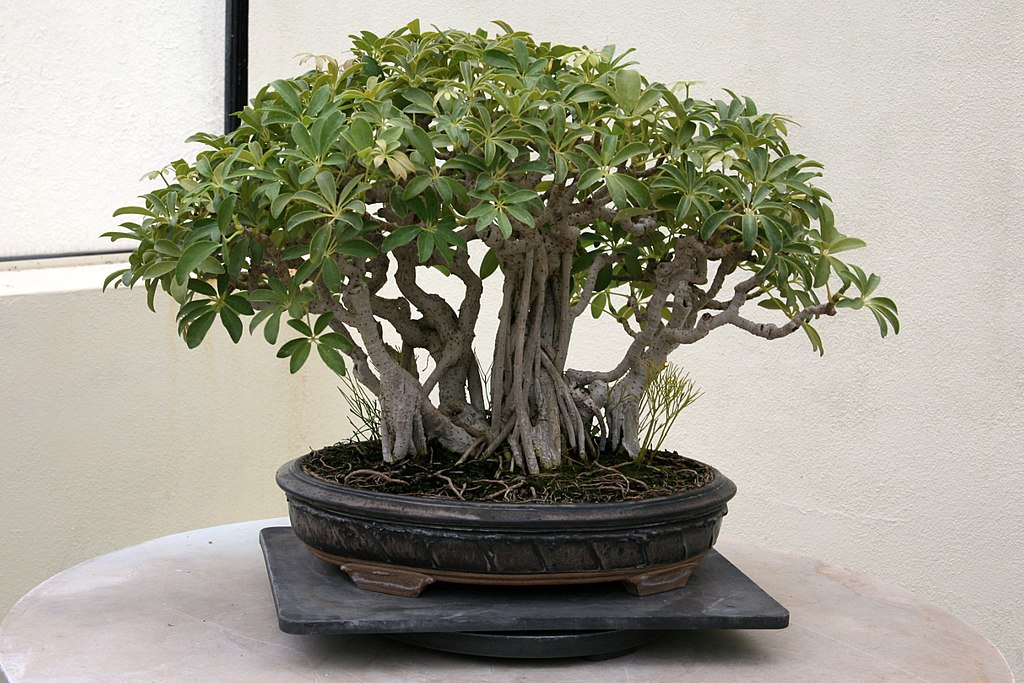
Pruning and Wiring
Dwarf Schefflera bonsai respond pretty well to pruning and wiring, allowing you to form them into various shapes and designs. Prune and wire during the active growing period. You can completely defoliate the tree every other spring to get a reduced leaf size.
When pruned, they back bud fairly well and produce new shoots after a hard cutback or even a full trunk chop. They don't branch as frequently as some other trees. Always sanitize your tools before pruning bonsai to reduce the risk of infection or cross-contamination.
After wiring, they hold their shape very well. Check the wiring frequently and remove or replace it when you see it cutting into the bark. Don't worry if you get some scarring; it will heal over time. You can also train your dwarf umbrella bonsai using the clip-and-grow approach by constantly cutting and shaping new growth.
Propagation
You can make new trees from Schefflera cuttings with ease. You will need to remove most of the leaves since the cutting will not have a root system to support the water required for photosynthesis until it develops roots. Put the cuttings into water or moist soil in a humid environment and mist them while developing roots. Cuttings root best in warm weather, but a heating pad can help in the cold months. Please keep them in low light until they grow a root system to support photosynthesis, which takes between 7 days and three weeks.